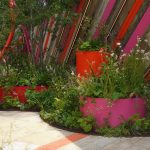Lighting For Gardens
Illuminating gardens
Good garden lighting can do so much more for your outdoor space than just being a practical solution. Well considered garden lighting can completely change the atmosphere in your garden from day to night. Garden lighting, when done well can help to create an enchanted space. As a garden designer, I always try and explain to clients the importance of garden lighting and why it should not be like Blackpool illuminations. It’s the old cliché of less is more. Whether you have a balcony garden, suburban garden, city garden, courtyard garden, country cottage garden, roof garden or a large rural estate, outdoor lighting should be subtle, warm, inviting and helping to create a relaxing cosy ambience. By zoning lights, you can create and change vistas.
 My garden Beneath a Mexican Sky at the Chelsea Flower Show was lit up with just a few lights provided by Landscapeplus. Less is more. The lighting gave the garden an enchanted ambience at night.
My garden Beneath a Mexican Sky at the Chelsea Flower Show was lit up with just a few lights provided by Landscapeplus. Less is more. The lighting gave the garden an enchanted ambience at night.
TIP
If you are getting your whole garden but the budget is not stretching to the outdoor lighting, at least get the first fix done by getting the conduits laid. This way the cabling in place to add the lights in at a later date.
Lighting for pathways and steps
There are many ways in which garden lighting can be used. The practical reasons are for safety and security. Illuminating paths and steps obviously provide safe passage when using them at night. However, if they are well considered they can add to the beauty and atmosphere you create in your garden. Depending on the design of your steps you could use recessed lighting on the treads, LED strip lights underneath the bullnose of the treads or if the steps have walls either side, you could use recessed lights with eyelids. Pathways can be lit with bollard lights, spread lights, or recessed lights. However, my favourite method for lighting pathways running alongside planting borders, is to put spike lights in the borders close to the edge so that light is also caste on the pathways. It also makes the pathway more interesting as you will see different patterns caste by the shadows of the plants.
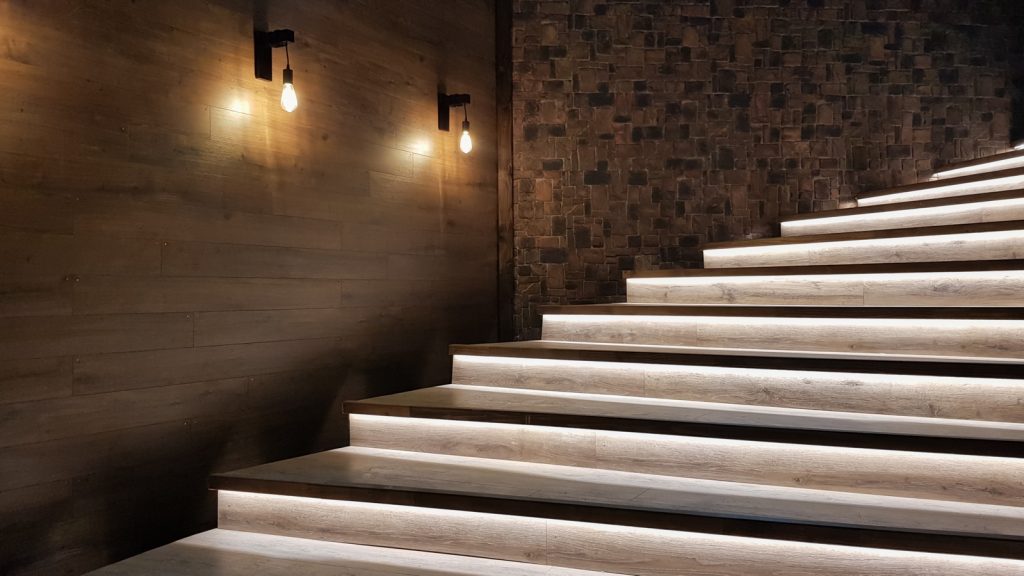 Outdoor steps should be lit at night for safety, but lighting can also make steps look beautiful and help to bring out the details. Here LED strip lighting has been hidden underneath the overhang of the step treads and at every riser it provides enough illumination for a safer journey.
Outdoor steps should be lit at night for safety, but lighting can also make steps look beautiful and help to bring out the details. Here LED strip lighting has been hidden underneath the overhang of the step treads and at every riser it provides enough illumination for a safer journey.
Lighting walls
Walls lit at night can create a sense of calm in a garden. Washing a wall with light will caste uniform light all over the wall. Purbeck walls and stone clad walls grazed with light look beautiful as the fine detail and textures are highlighted. Walls can be lit both up and down. For illuminating walls, you can use ground recessed lights, down lights, or up & down lights. However, the position dictates the angle and coverage of the light caste on the wall.
Lighting paths
Safety and practicality are of importance but so is aesthetics. Pathways where the lighting is considered can create a magical journey to a destination. Bollard lights work well but are suited public areas within residential developments. For private garden it is worth considering light fittings that will either graze the pathway with light or spread a soft circle of light. Mushroom head lights will caste a 360°. Markers lights are recessed into the pathway. The light will graze the path. The spread of light is dependent on the design of the fitting. Alternatively recessed eyelid lights can also be installed. The eyelid part of the design will stop you being blinded by the glare of the light. Pole spike lights are very popular. These come as single or twin head. I use them in planting borders, and they provide very good directional lighting for paths. One of my favourites is the halo pole light. It is a beautiful fitting that castes a halo of light illuminating both pathway and plants when positioned in borders at the edge of a path. Cleverly positioned lights alternating on either side of a path can create beautiful illuminating arcs along the path.
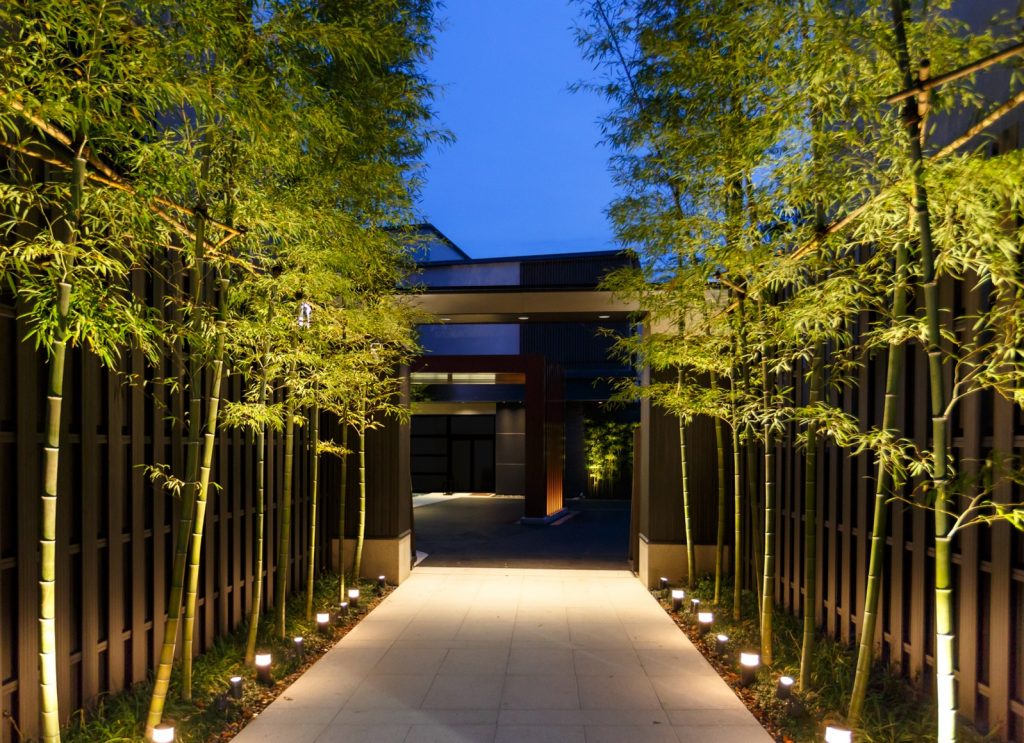
Well positioned pathway lights can create a magical journey through the garden. Here the pathway has been generously lit by short bollards. This has been combined with spike spots that are illuminating the canopy of the bamboo.
Lighting for decks and patios
For your social areas like decks and patios you want to create a cosy atmosphere with lighting. You can use bollards in these areas, but I prefer to use wall lights combined with either recessed or uplighters. The recessed lights are the same as used for pathways. The uplighters are also recessed, and some fittings give you the option to angle the lamp inside. Micro uplighters are more discreet due to their smaller size. The recessed halo is a beautifully designed fitting. It projects a 360° wash of light around the fitting like a halo.
If your decking is designed a slight overhang (rather like a bullnose on a step tread), it is worth considering strip LED lighting, recessed under the over hand to provide a lovely glow.
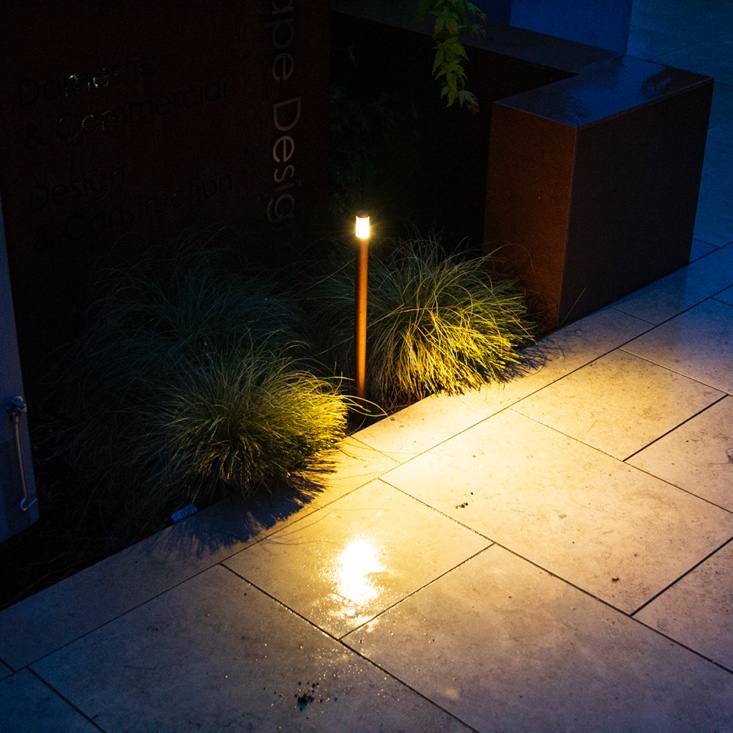
 Photo Credits: Landscapeplus
Photo Credits: Landscapeplus
Top Image: This copper wayfinder light is a beautiful fitting that can be installed at the edge of a pathway. It castes a beautiful warm glow across the path.
Bottom Image: The halo pole light is beautifully designed. It illuminates the path and the plants beneath with a soft ring of light.

Photo Credit: KG Electrical Contractors
It is not necessary to light every step. This discreet recessed light fitting gives sufficient light to illuminate the steps above and below from where it is positioned. Therefore lights can be positioned on every other steps and also on opposite sides to make the lighting that much more interesting.
Lighting for steps
Steps at night, if not lit, can become a hazard. It is worth considering lighting on steps. If steps run along walls, then recessed eyelid lights can be installed in the walls to project light on the tread. There are louvered options on recessed lights which will also caste light down onto the steps. Marker lights can also be used but these are recessed into the step tread.
LED strip lights can be recessed under the overhang of the tread. This is a beautiful detail for steps at night and provides safety.
Lighting for plants
Lighting your outdoor space adds beauty and enhances your garden at night. Think about what you are lighting and how the lights are positioned. Trees lit at night provide drama in a garden. Would you like your tree lit upwards with the light illuminating the canopy? Look for a fitting that will extend the light up to the height of your tree that also has a wide-angle beam. If you would prefer light projecting downward through the tree canopy creating shadows of the branches on the ground, then you need a fitting that will provide the effects of moonlighting. Angling lights through low branched trees and shrubs can help to create striking shadows on walls. Use the pole spike lights in your perennial borders and you will find that they will equally form stunning shadows. When a gentle breeze passes through the plants you will capture the shadows swaying and dancing.

Photo Credit: Landscapeplus
There is a wonderful calm feeling about illuminated water. Here the light fittings have been hidden underneath the cantilevered step. The light shooting through the water gives it a mirror quality. The agaves can be seen reflected in the water. The light fitting in the planting border helps to create dramatic shadows of the agaves on the wall.
Lighting for water in the garden
I love that luminescent quality that water is given with lighting inside. There is something very spellbinding about water that is lit at night. If you have fountain, light the point at which the water is coming out of the spout. If you have water at ground level, it is always a good idea to have it lit at night for safety. Still water can be lit but it’s good idea to diffuse the light. This can be done by using a frosted lens and placing at the bottom of the pool. If you have a pond with wildlife, it is better to position the lights closer to the surface so that it creates less disturbance for the wildlife, otherwise they will continue to be active. Moving water that is lit refracts the light. The beauty is the continuous changes you see of the light and the movement of the gleaming water.
If you a very complicated water feature and you want different lighting effects, my advice would be to engage a professional lighting designer.

Photo Credit: KG Electrical Contractors
It is always worth showing off your trees in the garden, especially when they have beautiful sculptural branch forms. In the dark gloomy days of winter when everything in the garden is dormant, this is more important as trees lit up will create interest within your outdoor space.
Choosing light fittings
Outside lights need to be both weatherproof and waterproof. This is why all lights are given an IP rating. IP means Ingress Protection. IP ratings tell us how well protected the light fittings are from ingress of solid particles and liquids. IP numbers are made up of two numbers. The first number tells us how well protected the fitting is against solid particles whilst the second number tells us of the protection level against liquids. The higher the number the better the protection. All light fittings that go under water should be IP68 or above. As a garden designer I tend to opt for IP65 to IP67 for all other light fittings.
The practicalities of lighting
It is a good idea to zone the lights around your garden. After all you do not want all the lights on in your garden at the same time. By zoning your lights, you can create different moods and vistas in your garden. You can group certain lights on different circuits to help you create zones. In winter when you are not sitting outside, you may just want your trees lit at night to provide that mystical atmosphere with the lights glowing through the evening mist.
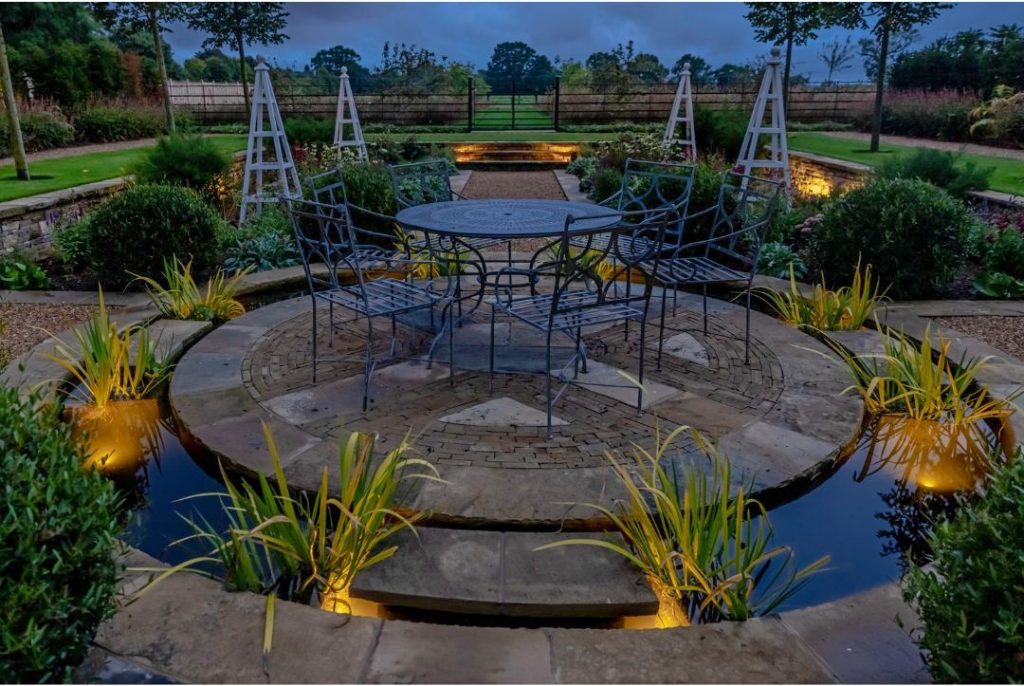
Photo Credit: Ornamental Garden Lighting & KG Electrical Contractors
The lighting in this water feature draws our attention to the circular shape of the seating area and the pattern created by the pavers. It then leads our eye further afield to the lights at the steps and the landscape beyond.
Can I use solar lights?
In a country where there is not guaranteed sunshine solar lights will not provide sufficient light to illuminate your whole garden. There are limitations to solar lights. The lights need to be positioned so that the solar panels get the maximum about of sun or daylight to convert into enough energy. If you live in a hot sunny country, solar lights are worth installing. I use security sensor solar lights in Crete, and they work very well. Solar lights are getting better and better so do not be discouraged to use a few in your garden but currently the developments are not advanced enough to provide your garden with enough light in all areas.
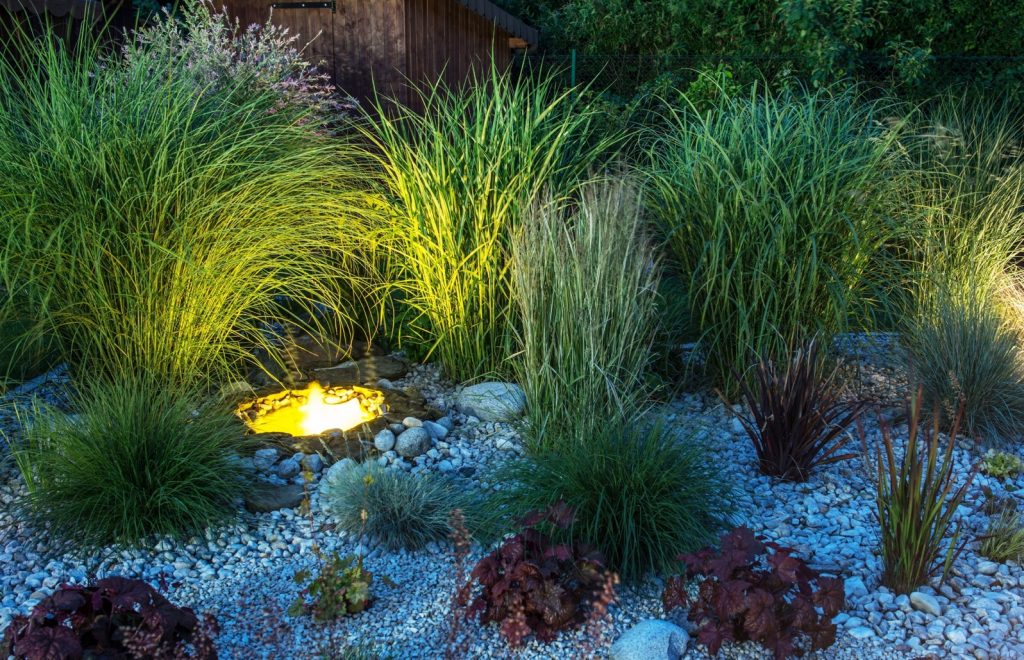
This small water feature lit at the point of the spout draws attention to the moving water. The light also draws attention to the grasses, their shape, texture, and movement as they sway in the breeze.
Fun with lights
There are fun ways to use lighting in the garden. For a party vibe swag some festoon lights back and forth, above on a pergola. Re-use old jam jars by adding some sand at the bottom of each jar and a tea light. These can be placed on table, windowsills or hung up on the branches of trees. Fairy lights wrapped around arches or moon gates can add a magical twinkle to the garden. I use battery operated fairy lights on a copper wire, gently scrunched and placed into glass storm jars. These create a beautiful and romantic ambience when combined with candles and flowers on an outdoor dining table. Candlelight is very alluring so use them in lanterns dotted around the patio There are items on the market that can be used as ornamental spheres, boulders, or pots during the day but light up at night.



